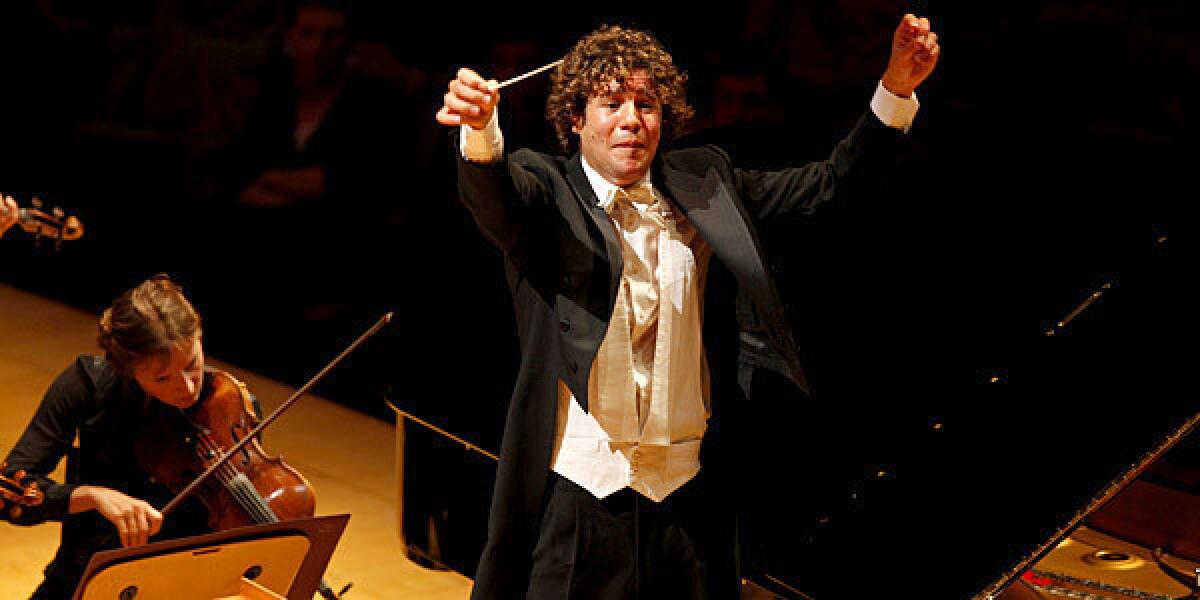Review: L.A. Phil guest conductor Robin Ticciati takes wrong turn

- Share via
In March 2010, Robin Ticciati, a 26-year-old British wonder, made his debut conducting the Los Angeles Philharmonic. A Simon Rattle protégé, Ticciati was at the time a newly appointed music director of the Scottish Chamber Orchestra and was said, perhaps, to be the next Dudamel. Since then his career has continued to rocket, as every year he adds more prestigious orchestras and opera companies to his guest-conducting card. He is principal guest conductor of the Bamberg Symphony, one of the best in Germany. In a little over a year, he will become music director of Britain’s Glyndebourne Festival Opera.
Ticciati obviously made a good first impression at Walt Disney Concert Hall; he was invited back. On Saturday afternoon, he conducted a program with the same soloist, pianist Lars Vogt, with whom he had appeared here in 2010. He also brought more Sibelius with him. Then it had been the minor “King Christian II” Suite. This time it was the major Symphony No. 2.
I didn’t hear Ticciati’s L.A. Phil debut, but it seems inevitable that a young conductor would have grown, changed, matured in the numerous concerts and operas he has conducted over the last 30 months. It may also be inevitable that anyone of Ticciati’s talent and precocity would take a few wrong turns. Rattle did at that age and stage in his career. So did Esa-Pekka Salonen. Gustavo Dudamel is not infallible.
Saturday’s concert had moments of great beauty, but Ticciati’s interpretations were also extreme and self-centered. For a pilgrim’s progress on the path toward self-discovery, the performance more often than not served the function of showing where not to proceed.
The two big pieces of the program were written in 1901 (although Sibelius’ symphony wasn’t finished until 1902). Vogt was soloist in Rachmaninoff’s Second Piano Concerto. The brief opening work of the afternoon, Anatoly Liadov’s once highly popular short tone poem, “The Enchanted Lake,” was also a product of the first decade of the 20th century. Interestingly, these pieces also all were played by the L.A. Phil within the first few years of its 1919 founding, when they were all new music.
In fact, the L.A. Phil has a special relationship with both of Rachmaninoff’s piano concertos. In 1942, the composer (who then lived in Beverly Hills) played the Second Concerto with the L.A. Phil at the Hollywood Bowl. Also that summer at the Bowl, Vladimir Horowitz was soloist on the Third Concerto. When Rachmaninoff took a bow onstage after Horowitz’s performance, he told an audience of 23,000 that this was the way he had “always dreamed the concerto would be played, but never expected to hear it that way on Earth.”
If Rachmaninoff’s own recording of the Second Concerto is anything to go by, he certainly never expected the Second to be played as it was Saturday. Vogt, a German pianist best known for his carefully controlled Mozart, Beethoven, Schubert, Brahms and Grieg, brought that same care and attention to Rachmaninoff. He did some peculiar things, such as arpeggiating the concerto’s famous opening chords. The score contains a Russian Romantic’s most swooning melodies. But by taking the kind of serious, detailed approach that he might for a Brahms concerto, the pianist made the melodies appear to swoon more, not less, than when the composer played them at considerably faster tempos and less emphatically.
As for Ticciati, he outright swooned. He has a lean build, bushy hair and a delicate manner on the podium. At his most graceful, he can seem swanlike in his gestures. At his most intense, he becomes somewhat awkward, more like a stork. In the Rachmaninoff, he tended to swoop up sound in his arms. Climaxes were great swelling events, separate from the rest of the music, and overwhelmed the piano.
In the quietly atmospheric “The Enchanted Lake,” Ticciati asked for the mystical intensity of Wagner, which is asking a lot of Liadov. The performance was slow and rapt. The Sibelius Second was slow, rapt and exaggerated.
The orchestral sound was the most impressive aspect of Ticciati’s Sibelius. He squeezed a luxuriant, bass-rich and brass-golden sound out of the L.A. Phil as naturally as toothpaste from a tube. On the microscopic level, he could create stunning effects, such as resolving leading tones with delicate, deliberate, even heart-stopping grace.
But the larger picture was a series of distortions. Sibelius’ unique instrumental textures were clotted. The symphony sounded as though it had become infected with a musical virus that caused little melodic or harmonic nodes to swell to the bursting point.
No one expects or should desire Ticciati to re-create the exhilarating brilliance of Salonen’s 2007 Sibelius Second recording with the L.A. Phil. A young conductor needs to find what the strange instrumental textures mean for him. Ticciati is clearly doing just that, on a mission of examining this symphony measure by measure. Right now they don’t add up. One day they may.
MORE:
CRITIC’S PICKS: Fall Arts Preview
TIMELINE: John Cage’s Los Angeles
PST: Art in L.A., 1945-1980
More to Read
The biggest entertainment stories
Get our big stories about Hollywood, film, television, music, arts, culture and more right in your inbox as soon as they publish.
You may occasionally receive promotional content from the Los Angeles Times.











